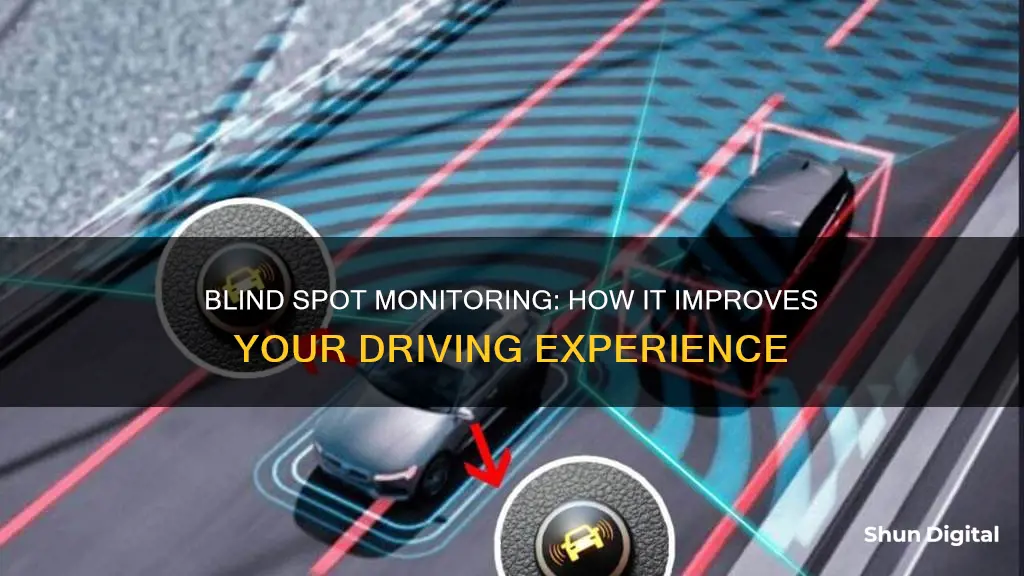
Blind-spot monitoring is a safety feature in cars that alerts drivers to vehicles in their blind spots, helping to prevent accidents when changing lanes. The system uses ultrasonic or radar sensors on the side and rear of the car to detect vehicles, motorbikes, and bicycles approaching or within a driver's blind spot. When a vehicle enters a driver's blind spot, a warning light will typically illuminate on or near the side mirror, or on the A-pillar, and an audible alert will sound if the driver indicates to change lanes. Some more advanced systems will also apply the brakes or nudge the car back into the centre of the lane to avoid a collision.
| Characteristics | Values |
|---|---|
| Purpose | To watch your blind spots and alert you if you attempt to make an unsafe lane change |
| Alert Types | Visual and audible |
| Alert Examples | Lights and beeps |
| Other Systems | Rear cross-traffic alert, lane-change assist |
| Location of Indicators | Side mirrors, A-pillar, driver-information display, head-up display |
| Sensors | Radar, ultrasonic, cameras |
| Sensor Location | Side mirrors, rear bumper, side of the vehicle |
| Vehicles with BSM | Toyota RAV4, Honda Civic, Chevrolet Equinox, Hyundai Elantra, Kia Forte, Nissan Sentra, Ford F-150, Ram 1500 |
What You'll Learn

How does blind spot monitoring work?
Blind-spot monitoring is a safety feature that uses sensors on the outside of a car to monitor the driver's blind spots and alert them if they attempt to make an unsafe lane change. This is often done through visual and audible alerts, such as lights and beeps, to help prevent accidents.
The system uses ultrasonic or radar sensors on the side and rear of the car to detect objects in the surrounding area. These sensors are usually quarter-size round indentations in the bodywork or fascias. They monitor nearby lanes and determine when other vehicles, or even smaller vehicles such as motorbikes and bicycles, approach or enter the driver's blind spot.
Once the system senses an advancing vehicle, it warns the driver through a visual or audible alert, or both. Visual alerts typically consist of a yellow warning light on or near the side mirror, or on the A-pillar (the pillar between the windshield and either front door). Some systems will also provide an audible alert, such as a beep or chime, especially if the driver indicates to merge while there is a vehicle in their blind spot.
More advanced systems will also provide steering assistance, nudging the driver away from the lane marker or even steering them back to the centre of the lane. These systems can also engage the brakes on one or more wheels to avoid a potential collision.
Auria Monitor: Locating the Model Number
You may want to see also

What are the limitations of blind spot monitoring?
Blind-spot monitoring is a safety feature that watches a vehicle's blind spots and alerts the driver if they attempt to make an unsafe lane change. While the technology is useful, it has some limitations.
Firstly, blind-spot monitoring systems typically only work at speeds above 20-35 mph, making them useful only at highway speeds. This limitation prevents false positives on city streets. Additionally, the audible alerts that accompany visual warnings often only work if the driver uses their turn signal, which not all drivers do.
It is also important to note that blind-spot monitoring systems are not a replacement for physically checking one's blind spots. While the technology is reliable, it is not foolproof, and drivers should not solely depend on it. Blind-spot monitoring systems can malfunction or give false alarms, especially in situations where a vehicle is passing through a tunnel wall.
Furthermore, not all blind-spot monitoring systems are created equal. Some may only function at certain speeds, and not every system can detect pedestrians, cyclists, or pets. More advanced systems may offer additional features such as lane-change assist or rear cross-traffic alerts, but these are not standard across all vehicles.
Lastly, while blind-spot monitoring can reduce the risk of accidents, it does not eliminate human error. Drivers must still remain vigilant and practice safe driving habits. Inattention or failure to respond to the system's warnings can still lead to accidents, even with blind-spot monitoring in place.
Monitoring PSU Usage: A Comprehensive Guide to Tracking Power Supply Performance
You may want to see also

What are the benefits of blind spot monitoring?
Blind-spot monitoring is a safety feature that helps prevent accidents by alerting drivers to vehicles in their blind spots. This is particularly useful for changing lanes or merging, as it can help to avoid crashes with vehicles in adjacent lanes. The system uses sensors and sometimes cameras to detect vehicles in the driver's blind spot, providing both visual and audible alerts to the driver.
There are several benefits to having blind-spot monitoring:
Safer Lane Changes
The primary benefit of blind-spot monitoring is that it helps to make lane changes safer by alerting drivers to the presence of vehicles in their blind spots. This is especially useful for larger vehicles, which tend to have bigger blind spots, and for vehicles with poor rear visibility, such as large trucks and SUVs.
Prevents Injuries and Reduces Damage
By reducing the likelihood of lane-change crashes, blind-spot monitoring also helps to prevent injuries and reduce the need for costly repairs to vehicles. A study by the IIHS found a 23% drop in lane-change crashes with injuries in vehicles equipped with blind-spot monitoring.
Increased Driving Awareness
Blind-spot monitoring provides drivers with increased awareness of their surroundings, alerting them to vehicles, and in some cases, pedestrians, that they may not have been able to see otherwise. This can be especially useful in busy parking lots or when driving in close quarters.
Improved Confidence and Peace of Mind
With blind-spot monitoring, drivers and passengers can feel safer and more confident on the road. The system provides an extra layer of security and peace of mind, especially when driving in heavy traffic or unfamiliar areas.
Early Warning and Quick Response
The early warning provided by blind-spot monitoring gives drivers more time to respond to potential hazards. The system alerts drivers as soon as a vehicle enters their blind spot, allowing them to adjust their speed or driving manoeuvres accordingly.
Monitoring Data Usage: Tracfone's Easy Steps to Track
You may want to see also

How much does it cost to install blind spot monitoring?
Blind-spot monitoring systems are safety features that monitor a driver's blind spots and alert them if they attempt to make an unsafe lane change. These alerts are usually visual and audible, with lights and beeps. While blind-spot monitoring systems are not a replacement for manually checking your blind spots, they are a convenient feature that can help prevent accidents and are proven to reduce injuries caused by lane-change crashes.
The cost of installing a blind-spot monitoring system varies depending on the features and specifications of the system. Basic blind-spot monitoring systems can be purchased for as little as $100, while more advanced systems with additional features can cost up to $750. The price of the system depends on factors such as the number of parts included, the type of radar sensor, the accuracy of the system, and the vehicle type.
For example, a budget blind-spot monitoring system with a single 24GHz radar and a single indicator light may cost between $100 to $150. On the other hand, a more advanced system with two 77GHz radars and a pair of warning lights may cost between $150 to $300. The most advanced systems, with features like advanced alarm systems, camera screens, and higher accuracy, can cost upwards of $350.
It is important to note that the installation cost of a blind-spot monitoring system is separate from the cost of the system itself. The installation cost can range from $100 to $200, depending on the complexity of the system and the qualifications of the installer. Professional installation is recommended for more expensive and complex systems.
When choosing a blind-spot monitoring system, it is essential to consider the size and type of your vehicle, as well as the level of accuracy and functionality you require. While basic systems may be more affordable, theyRelevant Documents: 0,3,4,5
Cited Documents: 0,3,4,5Blind-spot monitoring systems are safety features that monitor a driver's blind spots and alert them if they attempt to make an unsafe lane change. These alerts are usually visual and audible, with lights and beeps, to help prevent accidents. This technology is proven to reduce injuries caused by lane-change crashes.
The cost of installing a blind-spot monitoring system varies depending on the features included and the complexity of the installation process. Basic blind-spot monitoring systems can be purchased for around $100, while more advanced systems with additional features such as a buzzer alarm system, extra mirrors, or a built-in camera system, can range from $150 to $750. The installation cost for a blind-spot monitoring system typically ranges from $100 to $200, depending on the complexity of the installation.
Aftermarket blind-spot monitoring systems are available for vehicles that did not come equipped with this technology. These systems vary in price, with the most affordable options starting at around $250 and the most advanced systems costing $500 or more.
It is important to note that blind-spot monitoring systems are not a replacement for safe driving practices, such as checking your blind spot and using mirrors. However, they can provide an additional layer of safety and convenience for drivers.Blind-spot monitoring systems are safety features that monitor a driver's blind spots and alert them if they attempt to make an unsafe lane change. These alerts are usually visual and audible, with lights and beeps, to help prevent accidents. This technology is proven to reduce injuries caused by lane-change crashes.
The cost of installing a blind-spot monitoring system varies depending on the features included and the complexity of the installation process. Basic blind-spot monitoring systems can be purchased for around $100, while more advanced systems with additional features such as a buzzer alarm system, extra mirrors, or a built-in camera system, can range from $150 to $750. The installation cost for a blind-spot monitoring system typically ranges from $100 to $200, depending on the complexity of the installation.
Aftermarket blind-spot monitoring systems are available for vehicles that did not come equipped with this technology. These systems vary in price, with the most affordable options starting at around $250 and the most advanced systems costing $500 or more.
It is important to note that blind-spot monitoring systems are not a replacement for safe driving practices, such as checking your blind spot and using mirrors. However, they can provide an additional layer of safety and convenience for drivers.
Best Places to Buy Pet Monitor: A Guide
You may want to see also

Is blind spot monitoring worth it?
Blind-spot monitoring is a safety feature that uses sensors, cameras, ultrasonic sensors, and/or radars to detect vehicles, objects, or pedestrians in a car's blind spots. When the system detects something, it alerts the driver through visual, audible, or tactile warnings, such as flashing lights, beeping, or vibration of the steering wheel. This technology is especially useful for larger vehicles with bigger blind spots, such as SUVs and trucks, and for drivers who frequently transport passengers, such as children.
While blind-spot monitoring is not a replacement for manually checking one's blind spots, it is a valuable additional safety feature. A study by the IIHS found a 23% drop in lane-change crashes with injuries in vehicles with blind-spot monitoring. This technology can be particularly useful when driving on multi-lane roads or highways, where it can be challenging to keep track of surrounding vehicles.
In recent years, the cost of blind-spot monitoring technology has decreased, making it more accessible to a wider range of vehicles, not just luxury models. It is now commonly offered as an optional feature in many new cars, with some models including it as a standard feature.
When deciding whether to include blind-spot monitoring in your next vehicle, consider factors such as the size of the car, the efficiency of its visibility, and your personal preferences. Test-driving a vehicle with blind-spot monitoring can help you determine its value to you. While some drivers find it a valuable safety enhancement, others may prefer to drive without the potential distractions of the alerts.
In summary, blind-spot monitoring is a useful feature that can enhance safety and convenience, especially for larger vehicles or those with compromised visibility. However, it should be used in conjunction with responsible driving habits, including manually checking blind spots and using turn signals.
Zooming on an ASUS VivoBook Max Monitor: Easy Guide
You may want to see also
Frequently asked questions
Blind spot monitoring is a safety feature that uses sensors, cameras, and sometimes radar to detect vehicles, objects, or pedestrians in a car's blind spots.
When a vehicle enters a driver's blind spot, blind spot monitoring systems alert the driver through visual and/or audible warnings. Visual alerts typically consist of a flashing or constant light on the wing mirror, internal front pillar, or side mirror. Audible alerts include beeps, tones, or warning chimes. Some systems also provide haptic feedback through the steering wheel, such as vibration or a light shake.
Blind spot monitoring improves safety by reducing the risk of lane-change crashes and preventing accidents and injuries. It provides drivers with increased awareness, confidence, and peace of mind. The technology is especially useful for large trucks and SUVs with long tail ends and poor rear visibility.







